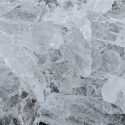What is Ammonium alum (Ammonium aluminum sulfate) in Food and Deodorant?

Production | Uses | Safety
Ammonium alum, also known as ammonium aluminum sulfate or aluminum ammonium sulfate, with the chemical formula NH4AI(SO4)2 and usually encountered as the dodecahydrate form NH4AI(SO4)2·12H2O. When used in food, it has the European food additive number E523.
When compared with another two common alums, it is used less in baking powder than sodium aluminum sulfate, and less common than potassium aluminum sulfate in deodorant.
How is Ammonium alum Made?
Different with potassium alum, which has natural and synthetic forms, aluminum alum occurs as a rare mineral in nature and is commercially produced by reacting ammonium sulfate solution with aluminum sulfate solution.
The following is the chemical reaction equation: Al2(SO4)3+(NH4)2SO4+24H2O→2(NH4)Al(SO4)2·12H2O. It dehydrates at about 250°C to produce aluminum ammonium sulfate anhydrous.
The aluminum sulfate comes from treating minerals bauxite ore (the main component aluminium oxide) with sulfuric acid. Here is the chemical reaction equation: Al2O3 + 3H2SO4 =Al2(SO4 )3 + 3H2O
And ammonium sulphate can be obtained by the reaction between aluminum sulfate and ammonium. Al2(SO4)3+ 6NH3·H2O→2Al(OH)3+3(NH4)2SO4
Property
| Other names | Ammonia alum |
| CAS number | 7784-26-1 |
| Chemical formula | NH4Al(SO4)2 (anhydrous), NH4Al(SO4)2·12H2O (dodecahydrate) |
| Molecular weight | 453.32 (dodecahydrate) |
Appearance
Large, colourless crystals or white powder with astringent taste.
Solubility
Freely soluble in water, soluble in ethanol.
What’re the Uses of Ammonium alum?
Ammonium alum is used almost for the same purposes as soda alum and potassium alum. It can be used as a leavening acid in baking powder, as a firming agent in pickling preparation, as an astringent in medicine, also in drinking water purification, dyeing textiles, tanning leathers and etc.
Ammonium alum vs potassium alum
Both can be used as a major component in deodorant and have advantages over aluminum chloride/chlorohydrate/zirconium, which are usual antiperspirants that function by blocking sweat ducts & glands and may be absorbed by skin.
There are mainly two differences: potassium alum is less acidic and has zero stinging than ammonium alum. Also, it is a more natural crystal deodorant compared with ammonium alum.
Is Ammonium alum Safe to Eat?
Alums are controversial ingredients as they have been suggested to be associated with Alzheimer’s disease and other neurodegenerative diseases in humans.
Although its safety as a food additive has been approved by the U.S. Food and Drug Administration (FDA), European Food Safety Authority (EFSA), as well as the Joint FAO/WHO Expert Committee on Food Additives (JECFA), its uses in food have limited or even banned in many countries, such as Europe (1), Japan (2) and China due to the restrictions for aluminum-containing food additives.
FDA
It is generally recognized as safe (GRAS) in food when used in accordance with good manufacturing practice. (3).
EFSA
Aluminum ammonium sulfate (E523) is listed in Commission Regulation (EU) No 231/2012 as an authorised food additive and categorized in “ Additives other than colours and sweeteners” (4).
JECFA
Function Class: food additives, buffer, neutralizing agent, colour fixative. (5)
Provisional Tolerable Weekly Intake (PTWI): a PTWI of 2 mg/kg bw was established for aluminium-containing food additives: aluminium ammonium sulphate, sodium aluminium phosphates (acidic and basic), sodium aluminosilicate, calcium aluminium silicate and aluminium silicate in 2011. (6)
Conclusion
Now you may have a knowledge of the alum – Ammonium Alum (E523), from the following aspects:
- Manufacturing process
- Uses
- Compare with potassium alum
- Safety
Featured image source


